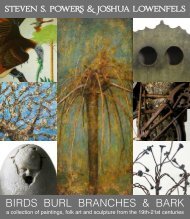SMALL FACES UNBOUND
SMALL FACES UNBOUND The title of this collection comes from the lyric in, The Byrds’ song, “Eight Miles High.” This ripe phrase evokes a range of fantastic imagery; uninhibited children, shrunken heads, unencumbered puppets and marvelous dismemberment to name a few things that popped into my head. Rather than discovering hidden faces or seeing them in inanimate objects (pareidolia), we focused on indelible visages—stark, psychological and philosophical—existential and mythological, some animal, some mysterious and some absurd. January 19-22, 2017. Metropolitan Pavilion, 125 W 18th St, New York, NY 1001. Additional show information: stevenspowers.com
SMALL FACES UNBOUND
The title of this collection comes from the lyric in, The Byrds’ song, “Eight Miles High.” This ripe phrase evokes a range of fantastic imagery; uninhibited children, shrunken heads, unencumbered puppets and marvelous dismemberment to name a few things that popped into my head.
Rather than discovering hidden faces or seeing them in inanimate objects (pareidolia), we focused on indelible visages—stark, psychological and philosophical—existential and mythological, some animal, some mysterious and some absurd.
January 19-22, 2017.
Metropolitan Pavilion, 125 W 18th St, New York, NY 1001. Additional show information: stevenspowers.com
Create successful ePaper yourself
Turn your PDF publications into a flip-book with our unique Google optimized e-Paper software.
OUTSIDER<br />
ART FAIR<br />
N E W<br />
Y O R K<br />
J A N U A R Y<br />
19-22, 2017
S T E V E N S . P O W E R S<br />
S M A L L FA C E S U N B O U N D<br />
The title of this collection comes from the lyric in<br />
The Byrds’ song, “Eight Miles High.” This ripe<br />
phrase evokes a range of fantastic imagery;<br />
uninhibited children, tiny heads, unencumbered<br />
puppets and marvelous dismemberment, to name<br />
a few things that popped into my head.<br />
Rather than discovering hidden faces or seeing<br />
them in inanimate objects (pareidolia), we focused<br />
on indelible visages—stark, psychological and<br />
philosophical—existential and mythological, some<br />
animal, some mysterious and some absurd.<br />
January 19-22, 2017.<br />
Metropolitan Pavilion, 125 W 18th St, New York, NY 10011<br />
additional show information: outsiderartfair.com<br />
W O R K S O F<br />
A R T<br />
& a m e r i c a n a<br />
360 Court Street #28, Brooklyn, NY 11231 | 718.625.1715 or 917.518.0809 | stevenspowers.com | member: ADA
Important Mesquakie Dog Effigy Ladle (detail)<br />
Tama, Iowa<br />
Carved wood, trade glass bead eyes, brass tacks<br />
Circa: 1840<br />
Size: 9 1/2" (oal) x 5 7/8" (w)<br />
full details on pages 34-35
Terracotta Toddler<br />
Architectural earthenware<br />
Circa: 1920<br />
Size: 12" (w) x 15" (d) x 24" (h)<br />
Provenance: Robert Reeves, Ricco/Maresca,<br />
Marvill Collection<br />
Pictured: The Clarion, Spring 1990<br />
Pictured and discussed: American Vernacular, page 165<br />
This figure is one of the most indelible images pictured<br />
in the folk art tome, American Vernacular. Found in an<br />
African American’s garden in Ohio, it is enigmatic and<br />
haunting.<br />
The slightly larger than life-sized toddler sits upon a<br />
stool—his hands rested on his outstretched legs. The<br />
figure, decidedly a baby, however has a full set of teeth<br />
and a pronounced Adam’s apple beyond his years.<br />
Eyebrows and hair are scratched in.<br />
The firing of the clay body has given the figure a burnt<br />
reddish-orange color—like a loaf of braided bread in a<br />
wood fired oven—or skin in the flickering light of a<br />
campfire.
This figure feels alive. His uncoordinated muscles are<br />
well rendered in the slightly off-balanced posture as is<br />
his minute head roll. The doughy build of his body and<br />
love-handles at his hips and buttocks gives us a sense of<br />
his weight.<br />
The scale of the figure is surprising and not often seen<br />
in folk art ceramics. The terracotta medium and the<br />
stock paver form upon which the baby sits suggests that<br />
the builder worked at a commercial ceramic factory. The<br />
insight of building technique, proper drying time before<br />
firing and access to a sizable kiln would also support<br />
this theory.<br />
Terracotta Toddler (back)<br />
Architectural earthenware<br />
Circa: 1920<br />
Size: 12” (w) x 15” (d) x 24” (h)
The Painted Tintype<br />
A tintype or ferrotype is a photograph made by creating a direct image<br />
onto a thin sheet of metal (there is no negative). From roughly 1860<br />
onwards tintypes saw a popularity through all social classes, as they were<br />
inexpensive, and quick and easy to make.<br />
The images were black and white, giving the now largely out of work<br />
itinerant portrait painters a new found opportunity to flesh out the sitters<br />
and bring them to life—and a new genre of American folk art painting<br />
was born.<br />
As with other folk art painting, we look for a certain sprezzatura or casual<br />
seriousness and a slight misalignment of earnest intent and artistic<br />
ability—something slightly off in craft, but otherwise on.<br />
*A note on condition: learn to accept peripheral scuffs, scratches and<br />
tonal shifts (ghosting from the original mat). The corners, which would<br />
have been hidden under the mats are often bent and/or have glue marks. I<br />
have chosen to embrace these marks of time and not over mat the images<br />
and present them edge to edge.<br />
Happy Baby<br />
Folk Art Painted Tintype<br />
Circa: 1860<br />
Size: +/- 6 1/2" x 8 1/2" (full plate)
Books Brothers<br />
Folk Art Painted Tintype<br />
Circa: 1860<br />
Size: +/- 6 1/2" x 8 1/2" (full plate)
Young Girl in Windsor Chair<br />
Folk Art Painted Tintype<br />
Circa: 1860<br />
Size: +/- 6 1/2" x 8 1/2" (full plate)
Serenity’s Child<br />
Aluminum Hat Form<br />
Circa: 1920<br />
Size: 11" (h) x 7 3/4" (d)
Carnival Knockdowns<br />
New England<br />
Carved wood, polychrome, animal hair, movable eyes<br />
Circa: 1900-1920<br />
Size: 19" (h) x 7 1/2" (w) each<br />
Provenance: Ricco/Maresca, Marvill Collection<br />
Pictured and discussed in American Vernacular, page 91.<br />
Two sets of three large and expressionistically painted knockdowns—each<br />
with a brutal personality. They have the palette<br />
and line quality of early Jackson Pollock, à la “The She Wolf.”<br />
The She Wolf / Jackson Pollock<br />
Oil on canvas / 1943<br />
Museum of Modern Art
“Spiritualist Criterium”<br />
Robert M. Clark, Formerly Sherif [sic], Ventura County, Califonia [sic]<br />
DeWitt State Hospital, Placer County, California<br />
Date: March 16 th 1954<br />
Size: 9" (w) x 12" (h)<br />
A fascinating seven page document written by a patient at the DeWitt State Hospital, California<br />
(the same hospital and period in which Martín Ramírez was institutionalized). The patient<br />
identifies as a “Robert M. Clark, former sherif [sic] of Ventura County,” and writes to “Dr. C. R.<br />
Jackson, MD In Charge” about a “morphinism disturbance.” He weaves in a cast of characters<br />
and a convoluted story involving morphine, prohibition and the Baptist Synod of Los Angeles to<br />
name a few details.<br />
The writing reminds one of William S. Burroughs’ morphine driven Dadaists vignettes of the<br />
1950’s. It’s vivid and at times quite engaging with some well structured thoughts and colorful<br />
phrases, however the whole is somewhat incohesive and difficult to follow—yet spellbinding!
Letters from (a State) Home<br />
Wrought by Verba Frazier (1900-1951)<br />
Mexia State Home, Mexia, Texas<br />
Circa: 1940’s<br />
Size of largest: 9" (h) x 6 1/4" (w)<br />
These poignant embroidered letters were wrought by Verba Frazier, a diagnosed<br />
schizophrenic (dementia praecox), from a state institution in Texas to her son,<br />
Hudson. These simple sentiments are rich with emotion and heartache.<br />
Verba Frazier was born in Pliny, West Virginia in 1900. She married John<br />
Hudson Pritchard and they had a son, Hudson in 1921. 1930 census records<br />
show the Pritchard family living together in Texas, however by 1940 Verba was<br />
divorced and living as an inmate at the Terrell State Hospital in Kaufman<br />
County, Texas. At some point she transferred to the Mexia State Home and<br />
lived there until her death in 1951.<br />
One of the letters is addressed to Hudson while he was living on West 77th<br />
Street in New York City. However, court records from the same period show<br />
Hudson in Los Angeles and getting into a bit of trouble with some minor burglaries—in<br />
one instance he was found wearing the clothes of the victim.
Iron Workers Mask<br />
Sheet metal<br />
Circa: 1900<br />
Size: 7 7/8" (h) x 7" (w)
(l) Rare Set of Four Puppet Heads<br />
Dayton, OH<br />
Carved wood, paint, glass marbles<br />
Circa: 1900<br />
Size: +/- 6" (h) x 4 1/2" (w) (each)<br />
(r) Clown Puppet Head<br />
Carved wood, paint, varnish<br />
Circa: 1900<br />
Size: 7 5/8" (h) x 3 1/2" (w)<br />
Provenance: Ricco/Maresca, Marvill Collection
African American Woman in Mourning<br />
Folk Art Painted Tintype<br />
Circa: 1860<br />
Size: +/- 6 1/2" x 8 1/2" (full plate)
African American Mother & Daughter<br />
Folk Art Painted Tintype<br />
Circa: 1860<br />
Size: +/- 6 1/2" x 8 1/2" (full plate)<br />
*notice the mother’s right hand, or lack thereof.
Mississippi Matrimony<br />
Wood and polychrome<br />
Circa: 1910<br />
Size of largest: 11" (h) x 5 1/4" (w) x 4" (d)<br />
Provenance: Natchez, Mississippi Estate<br />
A rare pair of folk art figures representing a man and wife<br />
(possibly on their wedding day). Each carved from the solid<br />
with unusual (for folk art), but classic marble-esque bases.<br />
The Southern gent with a goatee and black suit and his belle<br />
in a white dress and carved pearls. The intricate detail to<br />
the hair is especially great.
African American Young Woman<br />
Folk Art Painted Tintype<br />
Identified on back as, “Healey”<br />
“Eureka Photo Huntington W. VA”<br />
Circa: 1860<br />
Size: 5" x 7" (custom size)
African American Boy in Dapper Suit<br />
Folk Art Painted Tintype<br />
Circa: 1860<br />
Size: +/- 6 1/2" x 8 1/2" (full plate)
Hawaiian Ai-Laiki = Ricebird<br />
James W. Washington, Jr. (American 1909-2000)<br />
Dated: 1974<br />
Size: 7 1/2" (l) x 4 1/2" (d) x 7" (h)<br />
Provenance: Private Northwest Coast collection<br />
A striking, signature work carved from black granite—the<br />
bird is powerfully rendered with a commanding posture.<br />
James W. Washington, Jr. was a self-taught African-American<br />
artist known for his engaging works in stone. Born in Gloster,<br />
Mississippi, Washington settled in Seattle working as a<br />
government electrician.<br />
Washington’s spirited, but quiet carvings are often seen as a<br />
cross between two other direct carvers; the African American<br />
Folk Artist, William Edmondson (1874-1951) and American<br />
sculptor, John Flannagan (1895-1942).<br />
Washington's work is represented in numerous private and<br />
public collections, including The Smithsonian, the Whitney,<br />
SFMOMA and the Seattle Art Museum.<br />
Literature: Karlstrom, Paul J., THE SPIRIT IN STONE: THE<br />
VISIONARY ART OF JAMES W. WASHINGTON, JR., Bellevue<br />
Art Museum, 1989.; Ament, Deloris Tarzan, IRIDESCENT<br />
LIGHT, University of Washington Press, 2002.
Woodchuck Hatching<br />
James W. Washington, Jr. (American 1909-2000)<br />
Dated: 1977<br />
Size: 12" (l) x 7" (d) x 6 1/2" (h)<br />
Provenance: Private Northwest Coast collection<br />
Though Woodchucks do not hatch from eggs,<br />
Washington successfully reminds us that all animal<br />
life begins with an egg. Regarding a similar work, a<br />
patron who upon seeing a recent work of<br />
Washington’s in which a rabbit was hatching from<br />
an egg, exclaimed, “A rabbit does not come from an<br />
egg!” Washington replied, “Doctor, all life comes<br />
from an egg.”<br />
Washington's work is represented in numerous private and<br />
public collections, including The Smithsonian, the Whitney,<br />
SFMOMA and the Seattle Art Museum.<br />
Literature: Karlstrom, Paul J., THE SPIRIT IN STONE: THE<br />
VISIONARY ART OF JAMES W. WASHINGTON, JR., Bellevue<br />
Art Museum, 1989.; Ament, Deloris Tarzan, IRIDESCENT<br />
LIGHT, University of Washington Press, 2002.
Important Mesquakie Dog Effigy Ladle<br />
Tama, Iowa<br />
carved wood, trade glass bead eyes, brass tacks<br />
Circa: 1840<br />
Size: 9 1/2" (oal) x 5 7/8" (w)<br />
Provenance: by descent through the family of John Young Bear,<br />
Gaylord Torrence, Ned Jalbert, Steve Powers, Peter Brams,<br />
Private collection.<br />
Evan M. Maurer, Director Emeritus, The Minneapolis Institute<br />
of Arts writes of this ladle, “With careful renditions of<br />
anatomical details like the open mouth, the bright staring eyes,<br />
and the ears that stand up at attention, this canine is clearly a<br />
portrait of the owner’s favorite companion who participated in<br />
the hunt and protected the family.”<br />
This powerful ladle descended within the carving family of<br />
John Young Bear and was likely made by his father or<br />
grandfather. It is quite large with a wide and thinly hewn bowl.<br />
The dog’s head maintains a darkened and complex surface from<br />
generations of use.
In 1962, George E. Morgan was 91 years old and living in a rest home in Gardiner,<br />
Maine. Wanting to do more than paint-by-numbers, Morgan started painting<br />
“memory paintings” of his earlier life along the Kennebec River.<br />
Most of Morgan’s works are map-like landscapes, however these two figurative<br />
works display Morgan’s attention to detail and strong compositional skills. The<br />
painting to the right, “Hazzard Band,” illustrates the factory where he worked.<br />
Church Quire [sic]<br />
George E. Morgan (1870-1969)<br />
Oil on canvas board<br />
Dated: January 1964<br />
Size: 9" x 12"<br />
Provenance: Anne K. Wardwell; Mr. & Mrs. Sumner and Helen Johnston; Joe<br />
Wetherell; Raymond Saroff and Howard Rose; Peter Brams<br />
Exhibitions: The Playhouse, Boothbay, ME 1963; Farnsworth Art Museum,<br />
Rockland, ME, July 16 - October 11, 1998; The Center for Intuitive and Outsider<br />
Art, Chicago, IL, February 5 - April 10,1999
Hazzard Band, Gardiner<br />
George E. Morgan (1870-1969)<br />
Oil on canvas board<br />
Circa: 1963<br />
Size: 12" x 16"<br />
Provenance: Anne K. Wardwell; Mr. & Mrs. Sumner and Helen Johnston; Joe<br />
Wetherell; Raymond Saroff and Howard Rose; Peter Brams<br />
Exhibitions: The Playhouse, Boothbay, ME 1963; Farnsworth Art Museum,<br />
Rockland, ME, July 16 - October 11, 1998; The Center for Intuitive and<br />
Outsider Art, Chicago, IL, February 5 - April 10,1999<br />
Literature: “George E. Morgan; Self Taught Maine Artist,” FOLK ART<br />
MAGAZINE, Summer 1998, p. 32, Chippy Irvine
Two babies in Christening Dresses<br />
Folk Art Painted Tintypes<br />
Circa: 1860<br />
Size: +/- 6 1/2" x 8 1/2" (each full plate)<br />
Provenance: Dr. Stanley Burns<br />
The one of the left, identified on back as “Shaw.”<br />
Young Girl<br />
Folk Art Painted Tintypes<br />
Circa: 1860<br />
Size: 8" x 10" (large plate)<br />
Provenance: Dr. Stanley Burns
Large Folk Art Poppet of Young Man<br />
Circa: 1870-1890<br />
Size: 24 1/2" (oah)<br />
Provenance: Private Midwestern Collection<br />
Found a number of years ago in Kentucky, this<br />
large folk art carving is well executed with an<br />
expressive face and clothing details. The artist<br />
captured a slight sense of movement with a bend<br />
to the knees and the figure's hands going into his<br />
pockets. Remains of polychrome—black to hair<br />
and eyebrows, green lapels and a red shirt.
Young Siblings (Redheads)<br />
Folk Art Painted Tintype<br />
Circa: 1860<br />
Size: +/- 6 1/2" x 8 1/2" (full plate)
Man in Top Hat on a Cartoon Horse with Sun-Face Sky<br />
Folk Art Painted Tintype<br />
Circa: 1860<br />
Size: 2 11/16" x 3 7/8" (custom size)<br />
Provenance: Charles W. Jenks, Providence, RI (19thC<br />
collector of photography).
Important African American<br />
Folk Art Carved Cane<br />
Circa: 1881<br />
Size: 36" (oah)<br />
This spirited carving is not<br />
only remarkable for its’<br />
prodigious carvings, it is<br />
the inspired, non-formulaic<br />
execution that makes<br />
it exceptional.<br />
The forty or so carvings<br />
feature; a large capuchin<br />
monkey at the top with a<br />
turtle fetish set into it<br />
(under glass). What follows<br />
is a whole lot of carving;<br />
clusters of shore<br />
birds, 16 or so African<br />
American male heads, a<br />
few snakes, an elephant, a<br />
few dogs, etc.<br />
The male heads all appear<br />
to be African American<br />
which would point to the<br />
race of its carver. The cane<br />
is signed and dated, “BY<br />
TG 1881.”
African American Face Mask<br />
Glazed stoneware<br />
Circa: 1920<br />
Size: 7" (h) x 5" (w)
Folk Art Erotic Pull Toy<br />
Wood, polychrome, textile<br />
Circa: 1900<br />
Size: 14 1/4" (h)
The Toreador<br />
Edward Byrne (1877 - 1974)<br />
Missouri<br />
oil and pen on board<br />
Circa: 1970<br />
Size: 11" (w) x 6 3/4" (h)<br />
Provenance: Kronen Gallery, New York, NY<br />
Byrne came into painting at 87 years of age and while<br />
living at a rest home like George E. Morgan. He got his<br />
inspiration from newspaper clippings and local real<br />
estate advertisements. Although known for his<br />
semi-abstract architectural works, Byrne loved to paint<br />
animals as well.<br />
This work with its stark composition reminds one of<br />
Bill Traylor’s animal paintings.<br />
Byrne’s work was included in the show, “A Place for Us”<br />
at the American Folk Art Museum, 1996.
Reductive Milliner’s Head<br />
Wood, paint, paper<br />
Circa: 1900<br />
Size: 10" (h)
Study for Monument For Gold Star Mothers<br />
Clyde Angel (1920-2006)<br />
Camanche, Iowa<br />
White paper bag, black and red ink, gold foil<br />
Circa: 1991<br />
Size: 15" (l) x 9" (w)<br />
Born Vernon Clyde Willits, “Angel” was a career welder<br />
in Camanche, Iowa. A World War II veteran, he was<br />
self-taught as an artist and applied his professional<br />
vocation to construct his found object sculpture.<br />
His son Skip Willits, wanting to promote his father’s<br />
work concocted a convoluted and unnecessary “crazy,<br />
homeless, struggling artist” story to make the work<br />
more “meaningful”—it was baloney and tainted on his<br />
father’s credible work.<br />
For more read: “The Made-Up Life and Real Death of<br />
Clyde Angel: The identity of a popular but mysterious outsider<br />
artist is revealed. Or so it seems.”<br />
http://www.chicagoreader.com/chicago/the-made-up-lifeand-real-death-of-clyde-angel/Content?oid=1205382
Folk Art Make-Do Doll / Circa: 1950 / Size: 9" (h) / Provenance: Marvill Collection
Folk Art Preacher / Circa: 1880 / Size: 5 1/2" (h) / Provenance: Peter Brams Collection
New England Bat House / Carved pine, paint / Circa: 1880 / 16 5/8" (h)
Folk Art Head of a Surprised Man / Carved wood, paint, wool / Circa: 1910 / 7 1/2" (h)
Intense Baby in a Christening Dress<br />
Folk Art Painted Tintype<br />
Circa: 1860<br />
Size: +/- 6 1/2" x 8 1/2" (full plate)
Three Babies<br />
Folk Art Painted Tintypes<br />
Circa: 1860<br />
Size: +/- 6 1/2" x 8 1/2" (two full plate<br />
and one larger)
S T E V E N S . P O W E R S<br />
OUTSIDER<br />
ART FAIR<br />
N E W<br />
Y O R K<br />
J A N U A R Y<br />
19-22, 2017<br />
W O R K S O F<br />
A R T<br />
& a m e r i c a n a<br />
360 Court Street #28, Brooklyn, NY 11231 | 718.625.1715 or 917.518.0809 | stevenspowers.com | member: ADA


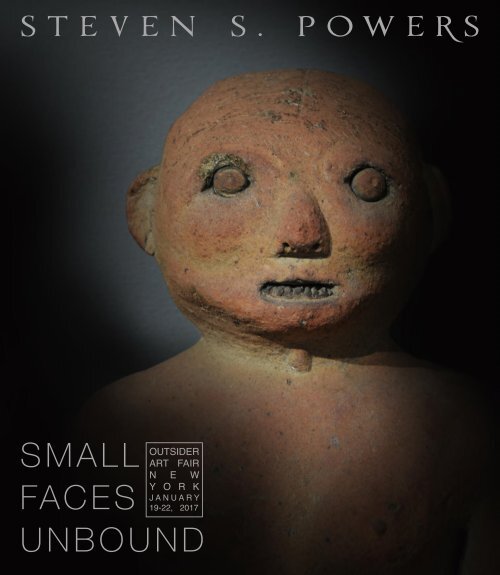

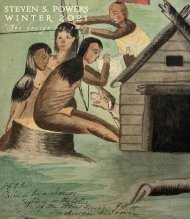
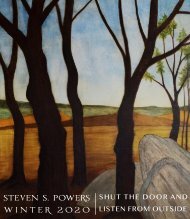
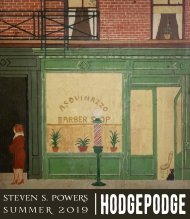
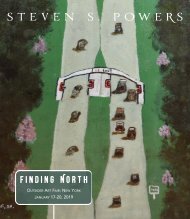

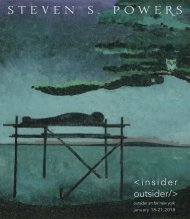
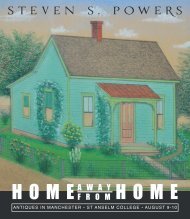
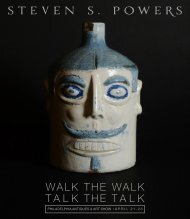
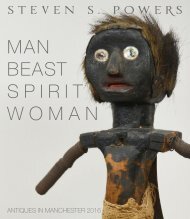
![NEEDLE • KNIFE • TORCH [&] BRUSH](https://img.yumpu.com/55309753/1/190x219/needle-o-knife-o-torch-brush.jpg?quality=85)
